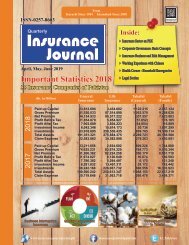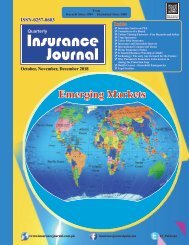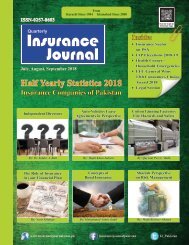Insurance Journal (1st Quarter 2019)
Create successful ePaper yourself
Turn your PDF publications into a flip-book with our unique Google optimized e-Paper software.
Guest Contribution<br />
adverse impact of hazards induced by<br />
climate change events. As the climate<br />
change is inevitable in foreseeable<br />
future, so is the vulnerability of the<br />
exposed communities, living in not so<br />
f a v o r a b l e c o n d i t i o n s . T h e<br />
governments by and large, in the<br />
developing countries, find it hard to<br />
plan and implement the hazard<br />
mitigating strategies, mainly due to<br />
l a c k o f v i s i o n , p r i o r i t y a n d<br />
institutional capacity, besides their<br />
limited ability to mobilize resources<br />
for the purpose. The communities in<br />
distress live in a state of oblivion, not<br />
knowing who would rescue them if<br />
t h e y w e r e h i t b y f l o o d s o r<br />
earthquakes. Hence the need for<br />
disaster risk insurance.<br />
Pakistan is being taken as a case<br />
study, keeping in view the fact that<br />
this piece of the globe is among the<br />
most vulnerable countries in the<br />
world with respect to climate-induced<br />
disasters, owing to its geographical<br />
location in Hindu Kash Himalaya<br />
(HKH) region.3<br />
The whole idea of nation-wide<br />
coverage and risk-averse measures<br />
through the instrument of innovative<br />
insurance products was conceived<br />
and developed by the author – the then<br />
Chairman NDMA Pakistan. The<br />
major driving force behind this<br />
thought process had been the<br />
unavoidable necessity of reducing<br />
risks, providing safety and creating<br />
jobs in the private sector. The scheme,<br />
if adopted by the government at<br />
national level, has the potential to roll<br />
out nearly 2.6 million jobs in a period<br />
of just one year after putting the risk<br />
insurance governance structure in<br />
place.<br />
The concept was floated in the<br />
industry to gauge the pulse. The<br />
response was phenomenal. “The<br />
S e c u r i t i e s a n d E x c h a n g e<br />
Commission of Pakistan (SECP)<br />
would be fully supportive of the idea<br />
of launching this policy forthwith”,<br />
r e m a r k e d M r A r i f A s i f ,<br />
Commissioner <strong>Insurance</strong> at SECP.<br />
The <strong>Insurance</strong> Institute of Pakistan at<br />
Karachi hosted an international<br />
conference on the possibilities of<br />
Catastrophe Risk <strong>Insurance</strong>, where<br />
this concept was officially presented<br />
by NDMA. Many leading global<br />
players of the insurance / reinsurance<br />
industry showed great interest in<br />
being part of this business plan. Most<br />
participants termed this initiative to<br />
be the biggest ever game changer in<br />
the global insurance industry, besides<br />
promoting the image of the country as<br />
a benevolent nation.<br />
Rationale:<br />
Most countries in South Asia are<br />
prone to a variety of disasters<br />
including floods, earthquakes<br />
cyclones etc. There is generally chaos<br />
like situation during every disaster,<br />
minor or major, about who would<br />
r e a c h o u t t o t h e s u f f e r i n g<br />
communities with what package of<br />
response in how much time and for<br />
how long. Reliance on funding from<br />
donors and multilateral financial<br />
institutions has major limitations in<br />
terms of efficiency, effectiveness and<br />
sufficiency, besides impacting the<br />
dignity and sovereignty of state at<br />
times. Shortfalls in resources affect<br />
the poor and vulnerable households<br />
the most and lead to discontentment<br />
and anger against the rulers.<br />
In Pakistan, the two major policy<br />
documents, i.e., National Disaster<br />
Risk Management Framework<br />
(NDRMF) and National Policy on<br />
Disaster Risk Reduction (DRR),<br />
abundantly provide for development<br />
of insurance schemes for disaster risk<br />
reduction as a priority.<br />
Pakistan's economy has suffered a<br />
loss of billions of dollars due to<br />
climate-induced disasters since 2005.<br />
The NDRMP calls for action on part<br />
of the governments to anticipate<br />
disaster threats and keep financial,<br />
material and human resources ready<br />
to roll out at once. Saving lives and<br />
commissioning humanitarian actions<br />
becomes the prime priority of the<br />
state at the times of catastrophe.<br />
Despite legislative support of the<br />
kind, the policy echelons shy away<br />
from making upfront allocations for<br />
disaster preparedness or response.<br />
One cannot even find any head of<br />
account in the budget books for<br />
allocating resources for the purpose<br />
either at national or provincial level.<br />
In order to share and spread the risk<br />
burden, the governments need to<br />
develop a model of micro insurance<br />
that encourages investments in<br />
disaster prevention and provide for a<br />
more dignified means of coping with<br />
disasters. Such scheme would not<br />
only put the vulnerable communities<br />
at ease but also support creation of<br />
jobs in private sector to plan, manage,<br />
deliver and monitor the insurance<br />
products among communities.<br />
<strong>Insurance</strong> <strong>Journal</strong> January, February, March <strong>2019</strong><br />
10<br />
Find us at: www.insurancejournal.com.pk — www.facebook.com/insurancejournalpakistan

















